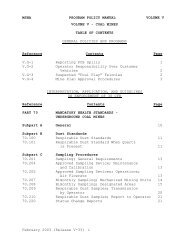MSHA HANDBOOK SERIES - PH13-V-1 - Mine Safety and Health ...
MSHA HANDBOOK SERIES - PH13-V-1 - Mine Safety and Health ...
MSHA HANDBOOK SERIES - PH13-V-1 - Mine Safety and Health ...
Create successful ePaper yourself
Turn your PDF publications into a flip-book with our unique Google optimized e-Paper software.
COAL MINE SAFETY AND HEALTH<br />
GENERAL INSPECTION PROCEDURES <strong>HANDBOOK</strong> CHAPTER 3<br />
Inspectors should be mindful of any limitations included in the regulatory text<br />
of the following st<strong>and</strong>ards, which incorporate NFPA consensus codes:<br />
§§ 75.1101-7 (Installation of water sprinkler systems; requirements); 75.1101-8<br />
(Water sprinkler systems; arrangement of sprinklers); 75.1107-3(b) (Fire<br />
suppression devices; approved components; installation requirements);<br />
75.1107-4(b) (Automatic fire sensors <strong>and</strong> manual actuators; installation;<br />
minimum requirements); 75.1107-13(b) (Approval of other fire suppression<br />
devices); 75.1107-16(b) (Inspection of fire suppression devices); <strong>and</strong> 75.1107-17<br />
(Incorporation by reference; availability of publications). For example, in<br />
accordance with § 75.1101-7(a), each sprinkler system must be installed, as far<br />
as practicable, in accordance with NFPA 13, “Installation of Sprinkler<br />
Systems.” NFPA 13 is the NFPA consensus st<strong>and</strong>ard for installation of fire<br />
protection sprinkler systems. Among other things, this consensus st<strong>and</strong>ard<br />
provides guidance on locating sprinklers, dealing with horizontal or vertical<br />
obstructions to sprinkler discharge water, specifying allowable types of pipes<br />
<strong>and</strong> fittings, <strong>and</strong> presenting methods for determining minimum pipes sizes.<br />
The electronic NFPA documents hyperlinked are provided as an additional<br />
resource to the hard copies you received previously. Do not distribute copies<br />
of these codes to non-<strong>MSHA</strong> persons, mines, <strong>and</strong> companies, because they are<br />
copyrighted by the NFPA.<br />
Again, it is being stressed that these are copyrighted documents <strong>and</strong> we<br />
have acquired them for only <strong>MSHA</strong>. Any further distribution outside of<br />
<strong>MSHA</strong> is a violation of <strong>MSHA</strong>’s license.<br />
The following check sheets may be used for inspector notes Form 2000-222<br />
Deluge; Form 2000-225 Dry Powder; Form 2000-234 Water Sprinkler. (Refer to<br />
Belt Air: 69 Fed. Reg. 17480 (April 2, 2004); <strong>and</strong> Flame-Resistant Belts 73 Fed.<br />
Reg. 80580 (Dec. 31, 2008) for additional information.)<br />
Documentation Required: The inspector should record in the inspection notes each<br />
belt flight, skip shaft facility <strong>and</strong> bunker that is inspected. The belt flight should be<br />
identified in the inspection notes as it appears in the ITS. The inspector is not required<br />
to document the inspection of conveyor belt flights by date <strong>and</strong> initials in the ITS. If a<br />
belt flight is not inspected in its entirety, the starting <strong>and</strong> stopping points, as<br />
correlated to a permanent reference point on the mine map such as a crosscut number<br />
or spad location should be included in the inspection notes. The inspector should<br />
clearly mark the extent of daily travels that contribute to the E01 inspection by date<br />
<strong>and</strong> initials on the mine tracking map <strong>and</strong> the beginning <strong>and</strong> ending point of each<br />
day’s travel, until the belt flight is fully inspected (this does not apply to routine travel<br />
of or incidental travel into the belt flight). The inspector shall record the completion of<br />
the 50 psi/50 gpm of water availability check in water lines at or near the working<br />
Release 1 (February 2013) 3-47
















